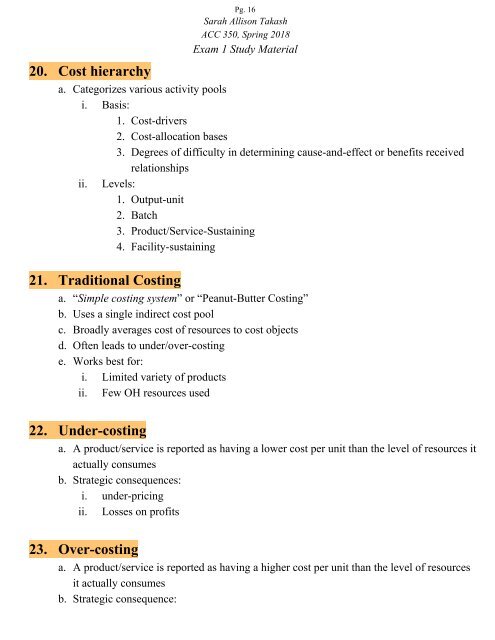(WIP) ACC 350 Exam 1 Study Material
Work in Process
Work in Process
Create successful ePaper yourself
Turn your PDF publications into a flip-book with our unique Google optimized e-Paper software.
20. Cost hierarchy<br />
Pg. 16<br />
Sarah Allison Takash<br />
<strong>ACC</strong> <strong>350</strong>, Spring 2018<br />
<strong>Exam</strong> 1 <strong>Study</strong> <strong>Material</strong><br />
a. Categorizes various activity pools<br />
i. Basis:<br />
1. Cost-drivers<br />
2. Cost-allocation bases<br />
3. Degrees of difficulty in determining cause-and-effect or benefits received<br />
relationships<br />
ii. Levels:<br />
1. Output-unit<br />
2. Batch<br />
3. Product/Service-Sustaining<br />
4. Facility-sustaining<br />
21. Traditional Costing<br />
a. “Simple costing system” or “Peanut-Butter Costing”<br />
b. Uses a single indirect cost pool<br />
c. Broadly averages cost of resources to cost objects<br />
d. Often leads to under/over-costing<br />
e. Works best for:<br />
i. Limited variety of products<br />
ii. Few OH resources used<br />
22. Under-costing<br />
a. A product/service is reported as having a lower cost per unit than the level of resources it<br />
actually consumes<br />
b. Strategic consequences:<br />
i. under-pricing<br />
ii. Losses on profits<br />
23. Over-costing<br />
a. A product/service is reported as having a higher cost per unit than the level of resources<br />
it actually consumes<br />
b. Strategic consequence:


